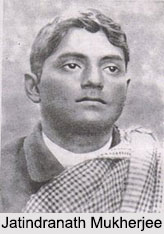 Jatindranath Mukherjee, popularly known as "Bagha Jatin" was a daring Indian freedom fighter from Bengal. He was an Indian revolutionary philosopher, resisting severely against British domination.
Jatindranath Mukherjee, popularly known as "Bagha Jatin" was a daring Indian freedom fighter from Bengal. He was an Indian revolutionary philosopher, resisting severely against British domination.
Life of Jatindranath Mukherjee
Jatindranath Mukherjee was born on 7th December 1879 in Kayagram, a village presently in Bangladesh. He spent his early life in his ancestral home until his father"s death. Since the age of 14, Jatindranath had asserted equal rights for Indian citizens in meetings organised by his family members inside railway carriages and public places. As Jatindranath grew older, he earned repute for physical bravery and intense strength.
After passing the Entrance examination in 1895, Jatindranath joined the Calcutta Central College (presently known as Khudiram Bose College), to study Fine Arts. Soon Jatindranath started to pay visits to Swami Vivekananda, whose social attentions and especially vision of a politically independent India had an everlasting influence upon him. Swami Vivekananda taught the Indian freedom fighters the art of conquering libido with "iron muscles and nerves of steel". On noticing his zealous desire to die for a cause, Vivekananda sent Jatindranath to the Gymnasium of Ambu Guha, where he himself had practised wrestling. Sick and tired of the colonial system of education, Jatindranath Mukherjee left for Muzaffarpore in 1899, as secretary to barrister Pringle Kennedy.
In 1900, Jatindranath Mukherjee married Indubala Banerjee of Kumarkhali in Kushtia. The couple had four children, namely Atindra (1903-1906), Ashalata (1907-1976), Tejendra (1909-1989) and Birendra (1913-1991). Moved by Atindra"s untimely death, Jatindranath with his wife and sister set out on a pilgrimage and regained their inner stability by receiving initiation from the Saint Bholanand Giri of Haridwar.
On returning to his native village Koya in March 1906, Jatindranath learned about the unsettling presence of a leopard in the vicinity. While reconnoitring in the nearby jungle, he came across a Royal Bengal Tiger and fought hand-to-hand with it. Mortally wounded, he managed to pitch a Darjeeling dagger in the tiger"s neck, slaying it right away. The famous surgeon of Calcutta, Lt. Colonel Suresh Sarbadhikari had taken upon himself the onus for treating his lethally wounded patient. Jatindranath"s whole body had been poisoned deeply by the tiger"s nails. Struck by his commendable valour, Dr. Sarbadhikari published an article about Jatindranath in the English press. The Government of Bengal awarded the freedom fighter with a silver shield with the scene of him killing the tiger inscribed on it. From thence, Jatindranath was renamed "Bagha Jatin" meaning "Jatin valorous like a tiger".
Revolutionary Activities of Jatindranath Mukherjee
Revolutionary activities of Jatindranath Mukherjee speak volume about his courage. He was amongst the foremost founders of the Anushilan Samiti in 1900 and as a ground-breaker in creating its branches in the districts. This, further delineated revolutionary activities in the then India.
Jatindranath Mukherjee possessed an in-born respect for the human being, irrespective of class, caste or religion.






